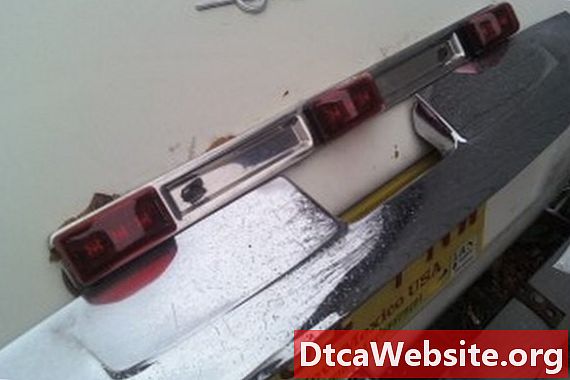
Contenu

Boat owners should routinely inspect and perform service maintenance on their Johnson outboard motors at frequent intervals. Doing so insures proper start-up and hours of pleasurable boating. Heat, friction and chemical pollutants in water can quickly compromise fuel and electrical systems. Since outboard motors have to work so hard all the time under constant torque, regular maintenance becomes all the more important in insuring smooth running and proper performance.
Step 1
Trailer the boat to a convenient work location, and stabilize the trailer against movement. Place the outboard motor in the full tilt down position. Inspect the propeller for nicks, cracks and bent blade tips. Pull the prop shaft back and forth and from side to side. Any excessive movement indicates wear or gap in the propeller shaft thrust bearing. Remove all debris from the propeller shaft, including wound fishing line or kelp. Cut the line or kelp away with wire cutters.
Step 2
Use a hydrometer or multimeter to check the charge of your auxiliary battery, if so equipped. Remove the plastic cell caps from the battery top and dip a hydrometer into one cell at a time. The hydrometer floats should read in the green for all cells. Yellow or red floats indicate a battery discharge or weak cell.
Step 3
Place the positive lead of a multimeter on the positive terminal of the battery and the multimeter negative lead on the negative battery terminal. It should read at least 12 volts, preferably 12.5 volts. Add distilled water to any low cell, up to the case neck. Charge the battery to its maximum standing volts.
Step 4
Hook up a flush device and garden hose to the lower unit fresh water intake ports. Use a piece of wire to probe the water intake ports on both sides of the lower unit, as well as the upper exhaust port. Clean all debris away from the intake and exhaust ports. Turn the hose on, and start the engine. Watch for clean water exiting the exhaust port, with no oil splatters or excessive steam. Flush the engine for at least 10 minutes to remove salt water and algae. Disconnect the flush device.
Step 5
Unclasp the engine top case cowl, and set it aside. Inspect the plug wire (or plug wires) for breaks and loose connections at the spark plug tip. The rubber plug wire boot should be free of cracks and fit firmly overly the plug tip. If your top engine case contains a pull rope ratchet for the recoil starter, examine it for free movement and dab some marine grease under the ratchet spacer. Examine the pull rope for frays and cuts. Clear any debris away from the flywheel.
Step 6
Use a plug socket to remove the spark plug. Check the electrode for excessive wear or carbon buildup. Use a wire brush to clean the electrode tip. Refer to your repair manual for the correct spark plug gap for your engine. Many Johnson plugs require 0.20, for example. Bend the electrode tang closer together by tapping it with a ratchet wrench, or use pliers to open it up. Screw the plug into the head by hand and tighten it with a socket.
Step 7
Locate the lower gear case oil plug and remove it with a socket or screwdriver. Let the gear oil drain into a pan. Remove the gear case filler plug. Insert the hose of a hand pump oil bottle into the drain plug and pump in gear oil until it seeps from the top filler plug. Replace the filler plug and tighten it with a socket or screwdriver. Quickly remove the pump bottle hose and replace the gear oil drain plug. Tighten it with a socket or screwdriver.
Step 8
Remove the engine crankcase oil plug with a socket or screwdriver and let the engine oil drain into a pan. Replace the drain plug and tighten it with a socket or screwdriver. Remove the dipstick. Refer to your owners manual for the proper oil volume of your crankcase. Fill the crankcase with new oil, using a hand pump oil bottle or funnel. Check the oil level with the dipstick.
Locate the grease zerks (nipples) on your motor mount swivel bracket and the steering linkage rods. Use a hand pump grease gun to inject grease into each zerk fitting. Check your repair manual for all your fitting locations, especially if you have electric trim tilt. Wipe away excess grease with a rag. If your motor has hydraulic trim, check the fluid reservoir for the correct level. Examine the hydraulic lines for leaks and tight fittings.
Tip
- Contrary to popular belief, many Johnson outboard lower units need to be filled with gear oil from the drain plug. This method is used so no air remains in the unit cavity when being displaced by oil. Check your manual just to be sure.
Items you will need
- Boat owners manual
- Wire cutters
- Hydrometer
- Multimeter (optional)
- Distilled water
- Battery charger (if applicable)
- Wire
- Flush device
- Marine grease
- Socket set
- Ratchet wrench
- Screwdrivers
- Wire brush
- Feeler gauge
- Pliers
- Drain pan
- Hand pump (oil bottle)
- Gear oil (lower case)
- Engine oil
- Funnel (optional)
- Lube gun
- Rags


